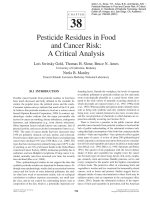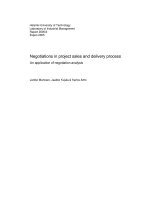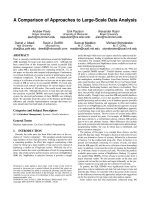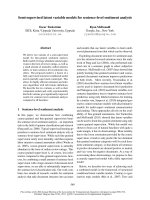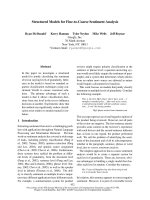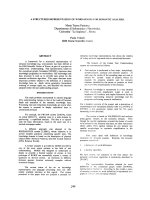Efficiency Benefit-Cost Analysis pdf
Bạn đang xem bản rút gọn của tài liệu. Xem và tải ngay bản đầy đủ của tài liệu tại đây (124.38 KB, 24 trang )
© Harry Campbell & Richard Brown
School of Economics
The University of Queensland
BENEFIT-COST ANALYSIS
BENEFIT-COST ANALYSIS
Financial and Economic
Financial and Economic
Appraisal using Spreadsheets
Appraisal using Spreadsheets
Ch. 5: Efficiency Benefit-Cost Analysis
Efficiency Benefit-Cost Analysis
•
Deals with the overall net benefits of the project irrespective
of who gains and loses.
•
Measures the economic efficiency of the project: if net benefit is
positive, the project is a more efficient allocation of resources than
the alternative (the world “without” the project).
The distribution of net benefits is not relevant
in efficiency benefit-cost analysis
•
the project net benefit, as measured by the efficiency analysis,
will accrue to various groups in various forms:
-
the private sector proponents of the project, in the form
of profits
-
the public sector, in the form of taxes or charges
-
the general public, in the form of employment benefits,
rents, pollution costs etc.
What is the standard methodology?
Decision
Undertake
the Project
Do not Undertake
the Project
Scarce Resources
Allocated to the Project
Scarce Resources Allocated
to Alternative Uses
Value of Project
Output
Value of Output from
Resources in Alternative Uses
Project Benefit = $X Project Opportunity
Cost = $Y
If X>Y, recommend the project
Figure 1.1: The “With and Without” Approach to Cost-Benefit Analysis
The efficiency benefit-cost analysis is based on the “with and
without” approach.
In measuring project benefit ($X) and project opportunity cost ($Y):
- ALL project outputs and inputs must be valued
-
the prices used in the valuations must accurately reflect value
or opportunity cost to the economy
In attempting to measure value or opportunity cost, it is natural to
look to the private market system. However:
-
some project outputs or inputs may not be traded in markets
e.g. pollution, outdoor recreation
-
in some markets, the market price does not accurately measure
the value of an output or the opportunity cost of an input.
Summary
In conducting efficiency benefit-cost analysis we will be faced with
two kinds of problems:
- missing markets, e.g. pollution, recreational fishing
-
markets in which market price does not measure value to the
economy, e.g. non-competitive markets, markets distorted by
taxes or regulations
We deal with these two problems using:
- non-market valuation techniques, e.g. contingent valuation
-
shadow-pricing techniques – adjusting observed market prices
to make them reflect marginal benefit or marginal cost to the
economy.
Shadow-pricing: adjusting observed market prices to make them
reflect marginal benefit or marginal cost to the economy.
When markets are distorted (by regulations or taxes) or are non-
competitive (because of monopoly or monopsony), in effect, there
are two prices corresponding to the equilibrium quantity traded –
one reflecting demand conditions and one reflecting supply
conditions.
There is a pricing rule telling us which is the appropriate price to
use in benefit-cost analysis.
We now consider the pricing rule and why it is required.
Figure 5.1: The Efficiency Benefit-Cost Analysis Pricing Rule
VALUED AT EQUILIBRIUM POINT ON A:
ITEM TO BE VALUED
DEMAND CURVE
SUPPLY CURVE
OUTPUT
SATISFIES ADDITIONAL
DEMAND
SATISFIES EXISTING DEMAND
FROM ALTERNATIVE SOURCE
INPUT
SOURCED FROM AN
ALTERNATIVE MARKET USE
SOURCED FROM ADDITIONAL
SUPPLY
Figure 5.2: Competitive Market Equilibrium
E
Quantity/year
P
0
S
0
Price
$/unit
S
1
P
1
O
0
O
1
D
Figure 5.3: The Effect of a Minimum Wage
W
a
Q
d
Labour Hours/year
S
W
m
Wage
$/hour
Q
s
D
Suppose a small quantity of labour is to be hired to undertake a
project with output valued at $B.
There are two possibilities regarding the opportunity cost of the
labour:
1. the labour would otherwise have been employed at wage w
m
;
2. the labour would otherwise have been unemployed with an
opportunity cost of w
a
.
•
In the first case the net benefit is $B - w
m
L.
•
In the second case the net benefit is $B - w
a
L; in this case,
if w
m
was used to cost the labour, the project net benefit would be
understated by (w
m
- w
a
)L, which is the value of the jobs (the
employment benefits).
Figure 5.6: The Market for an Imported Good Subject to a Tariff
P
w
S
D
Quantity of Imported Goods (units/year)
Q
Price
$/unit
P
b
S
D
Q
D
Figure 5.7: The Market for Diesel Fuel Subject to a Subsidy
S
s
S
D
Quantity/year
Price
$/unit
P
s
P
Figure 5.8: Demand and Costs in the Electricity Industry
Price,
Cost
D
Q
AC
Output
per year
$/unit
P
m
P
MC
Figure 5.9: Demand For Labour by a Monopoly
MRP
L
VMP
Labour Units/year
Wage
$/unit
W
W
P
S
Figure 5.10: Supply of Labour to a Monopsony
L
Labour units/year
W
P
$/unit
MFC
S
VMP
W
Figure 5.1: The Efficiency Benefit-Cost Analysis Pricing Rule
ITEM TO BE VALUED VALUED AT EQUILIBRIUM POINT ON A:
Demand Curve Supply Curve
Output
Input
Satisfies Additional
Demand
Satisfies Existing Demand
from Alternative Source
Sourced from an
Alternative Market
use
Sourced from
Additional Supply
•
gross of tax (F.5.12)
•
net of subsidy
•
net of tax (F.5.6)
•
gross of subsidy
•
gross of tax
•
net of subsidy
•
net of tax
•
gross of subsidy (F.5.7)
What is the logic of the efficiency pricing rule in the presence of
distortionary indirect taxes or subsidies?
– When a project output meets additional demand, or when a
project input is diverted from an alternative use, the appropriate
price is a point on a demand curve.
A point on a demand curve is the supply price plus indirect tax (i.e.
gross of tax), or the supply price less subsidy (i.e. net of subsidy).
– When a project output satisfies additional demand from an
alternative source, or when a project input is in addition to
existing supply, the appropriate price is a point on a supply
curve.
A point on a supply curve is the demand price less indirect tax
(i.e. net of indirect tax), or the demand price plus the subsidy
(i.e. gross of subsidy).
Figure 5.6: The Market for an Imported Good Subject to a Tariff
P
w
S
D
Quantity of Imported Goods
(units/year)
Q
Price
$/unit
P
b
S
D
Q
D
Figure 5.7: The Market for Diesel Fuel Subject to a Subsidy
S
s
S
D
Quantity/year
Price
$/unit
P
s
P
What happens if the indirect tax or subsidy is a corrective tax or
subsidy?
A corrective tax (subsidy) is intended to discourage (encourage) an
activity that is at too high (low) a level as a result of market forces.
Example: the tax on tobacco. Suppose that a project is designed
to satisfy additional demand for cigarettes.
If the tobacco tax is distortionary, the pricing rule tells us to value
the additional output at the price gross of tax (i.e. including the tax).
If the tobacco tax is corrective (intended to discourage
consumption), the pricing rule tells us to value the output at the net
of tax price.
Figure 5.12: A Consumer Good Subject to an Indirect Tax
Q
D
MR
S
Output (units/year)
Price,
Cost
$/unit
P
s
P
b
S + t
Now consider an input which is subject to a corrective tax: for
example, suppose the tax on diesel fuel is set at the level of the
marginal cost of the air pollution resulting from use of diesel.
If the fuel used as an input to the project is sourced from additional
supply, the pricing rule under distortionary taxation is to use the net
of tax price as a measure of opportunity cost.
If the diesel fuel tax is corrective, we would use the gross of tax
price to measure opportunity cost: the price net of cost measures the
marginal production cost, and the tax measures the marginal external
cost.
When an output (input) is in addition to current demand (supply)
and is subject to a corrective tax, we use the net (gross) of tax
price to measure benefit (cost).
In the same circumstances, if there was a corrective subsidy
(designed to encourage demand or supply), we would use the
unsubsidized price to measure benefit and the subsidized price to
measure cost.
If the output (input) satisfies existing demand from an alternative
source (is sourced from an alternative market use), there is no need
to modify the pricing rule to account for corrective taxes or
subsidies, as the level of the external benefit or cost does not
change.



